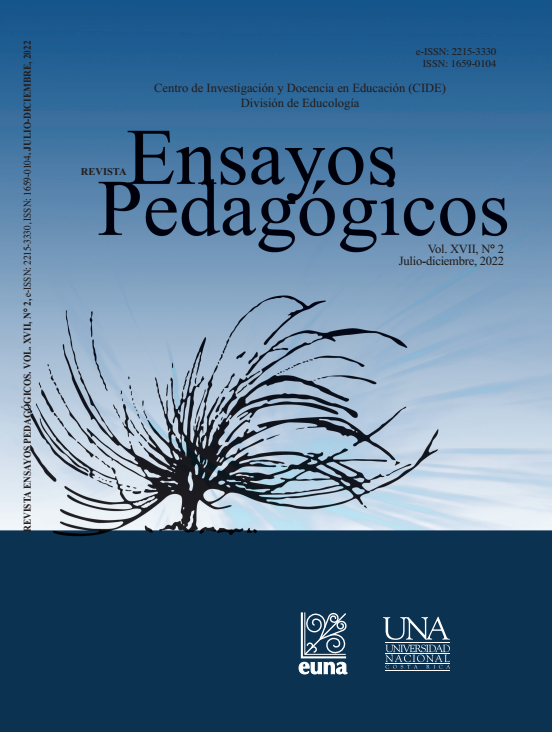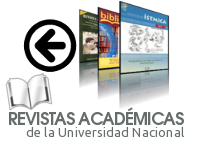Revisión bibliográfica de la comprensión lectora en personas adultas estudiantes: insumos para la educación distancia en Costa Rica
DOI:
https://doi.org/10.15359/rep.17-2.16Palabras clave:
Comprensión lectora, educación a distancia, lectoescritura, lectura en adultos, lectura universitariaResumen
La comprensión lectora es de suma importancia para la educación a distancia (EaD), pues esta aún depende del texto escrito para transmitir la información en las asignaturas. Así, el objetivo de este texto es describir la forma en la cual se documenta la comprensión lectora de estudiantes adultos, mediante una revisión bibliográfica, para la generación de insumos que facilite la toma de decisiones en la educación a distancia (EaD) en Costa Rica. Se realizó una revisión bibliográfica sistemática de tres etapas, la cual incluyó un protocolo de revisión, uso de operadores booleanos (AND + / OR = / NOT -), criterios de inclusión y exclusión de documentos, y el uso de cuatro bases de datos para la búsqueda de documentos. El principal resultado revela que no existe un acuerdo común para brindar un parámetro de comprensión lectora. Este varía entre porcentaje, palabras por minuto (X̅ = 183,05 ± 68,92) y otros indicadores (estadísticas). En conclusión, se desconoce la capacidad real de comprensión lectora de las personas estudiantes de EaD, en Costa Rica, y es necesario tomar más de un insumo para su determinación; además, se recomienda explorar el uso de las tecnologías de la información y comunicación (TIC), para que estas faciliten una recolección de datos más asertiva para la comprensión lectora en personas estudiantes adultas.
Referencias
Arguedas-Ramírez, L. (2020). Implicaciones educativas de los hábitos de lectura en el comportamiento académico del estudiantado universitario a distancia. Revista Electrónica Calidad en la Educación Superior, 11(1), 81-110. https://doi.org/10.22458/caes.v11i1.2936
Amirkhan, J. y Kofman, Y. (2018). Stress overload as a red flag for freshman failure and at-trition. Contemporary Educational Psychology, 54, 297-308. https://doi.org/10.1016/j.cedpsych.2018.07.004
Barahona, M. (2017). Estudio exploratorio sobre los hábitos de lectura entre la población estudiantil de la UNED: una aproximación metodológico conceptual al proceso de investigación. Programa de Investigación en Fundamentos de la Educación a Distancia (PROIFED), UNED.
Baron, N. (2017). Reading in a digital age. Phi Delta Kappan, 99(2), 15–20. https://doi.org/10.1177/0031721717734184
Bharuthram, S. (2017). The reading habits and practices of undergraduate students at a higher education institution in South Africa: a case study. The Independent Journal of Teaching and Learning, 12(1), 50–62. https://journals.co.za/doi/abs/10.10520/EJC-77dc5a5d0
Brizuela, A., Pérez, N. y Rojas G. (2019). Validación de una prueba de comprensión lectora para estudiantes universitarios. Revista Educación, 44(1), 1-14. https://doi.org/10.15517/revedu.v44i1.34983
Brussee, T., van Nispen, R. y van Rens, G. (2017). Visual and personal characteristics are associated with reading performance in normally sighted adults. Clinical and Experimental Optometry, 100(3), 270–277. https://doi.org/10.1111/cxo.12482
Brysbaert, M. (2019). How many words do we read per minute? A review and meta-analysis of reading rate. Journal of Memory and Language, 109, 104047. https://doi.org/10.1016/j.jml.2019.104047
Cassany, D. y Aliagas, C. (2007). Miradas y propuestas sobre la lectura. Revista Aula de Innovación Educativa, 162, 18-22. https://repositori.upf.edu/bitstream/handle/10230/25555/cass_aliag_aula_mira.pdf?sequence=1
Cassany, D. (2021) Lectura crítica en tiempos de desinformación. Revista Electrónica Leer, Escribir y Descubrir, 1(9), 20-37. https://digitalcommons.fiu.edu/led/vol1/iss9/3
Castro, J. (2018). La mayoría de edad como presuncióniuris tantum de capacidad en los códigos civiles y canónicos. IUS CANONICUM, 58, 1-42. https://doi.org/10.15581/016.116.004
Chon, Y. (2017). Motivational and Strategic Profiles of EFL University Learners as Predictors of L2 Reading Proficiency. The Journal of Linguistic Science, 83(12), 373–399. https://repository.hanyang.ac.kr/handle/20.500.11754/116474
Ciuffo, M., Myers, J., Ingrassia, M., Milanese, A., Venuti, M., Alquino, A., Baradello, A., Stella, G. y Gagliano, A. (2017). How fast can we read in the mind? Developmental trajectories of silent reading fluency. Reading and Writing, 30(8), 1667–1686. https://doi.org/10.1007/s11145-017-9744-2
Carpio, M. y Méndez, E. (2016). Validación de contenido léxico de los textos para la comprensión lectora del Test de Lectura y Escritura en Español (LEE) para su aplicación en Costa Rica. Actualidades Investigativas en Educación, 16(2), 74-102. https://doi.org/10.15517/aie.v16i2.23923
Conejo, L. y Carmiol, A. (2007). Conocimientos sobre la lectoescritura emergente y prácticas en las aulas para su promoción: Un estudio con docentes de Educación preescolar en Costa Rica. Revista Costarricense de Psicología, 36(2), 105-121. https://t.ly/FUJ4
Cortes, J., Daza-Acosta, J. y Castañeda-Polanco, J. (2019). Relación del entorno socioeconómico con el desempeño de la comprensión lectora en universitarios. Revista de Ciencias Sociales, XXV(4), 119-133. https://dialnet.unirioja.es/servlet/articulo?codigo=7202003
Creswell, J. y Creswell, J. (2018). Qualitative, Quantitative, Mixed Methods Approaches. SAGE Publications.
Davidovitch, N., Yavich, R. y Druckman, E. (2016). Don’t Throw Out Paper and Pens Yet: On the Reading Habits of Students. Journal of International Education Research, 12(4), 129–144. https://doi.org/10.19030/jier.v12i4.9799
del Puerto, L., Thoms, C. y Boscarino, E. (2018). Nivel de comprensión lectora en estudiantes que inician primer año de carrera universitaria. Revista Científica de la UCSA, 5(2), 11-25. https://t.ly/iVDz
Dirix, N., Vander, H., De Bruyne, E., Brysbaert, M. y Duyck, W. (2019). Reading Text When Studying in a Second Language: An Eye-Tracking Study. Reading Research Quarterly, 55(3), 371–397. https://doi.org/10.1002/rrq.277
Dolgunsoz, E. (2016). Using Eye-Tracking to Measure Lexical Inferences and its Effects on Reading Rate during EFL Reading. Journal of Language and Linguistic Studies, 12(1), 63–78. https://dergipark.org.tr/en/pub/jlls/issue/36116/405562
Donsbach, C., Stinton, K., Anderson, T., Levine, D., McDonald, S. y Donsbach, C. (2020). Determining how much is too much assigned reading in graduate school. ReSEARCH Dialogues Conference proceedings. https://scholar.utc.edu/research-dialogues/2020/day2_posters/46
Durango, Z. R. (2017). Niveles de comprensión lectora en los estudiantes de la Corporación Universitaria Rafael Núñez (Cartagena de Indias). Revista Virtual Universidad Católica del Norte, 51, 156-174. http://revistavirtual.ucn.edu.co/index.php/RevistaUCN/article/view/850/1368
Ekholm, C. (2020). Reading and Teaching Literature as Writing. Educational Theory, 70(1), 11–20. https://doi.org/10.1111/edth.12402
Eppard, J., Baroudi, S. y Rochdi, A. (2020). A case study on improving reading fluency at a university in the UAE. International Journal of Instruction, 13(1), 747–766. https://doi.org/10.29333/iji.2020.13148a
Farinosi, M., Lim, C. y Roll, J. (2016). Book or screen, pen or keyboard? A cross-cultural sociological analysis of writing and reading habits basing on Germany, Italy and the UK. Telematics and Informatics, 33(2), 410–421. https://doi.org/10.1016/j.tele.2015.09.006
Fatiloro, O., Adesola, O., Hameed, B. y Adewumi, O. (2017). A Survey on the Reading Habits among Colleges of Education Students in the Information Age. Journal of Education and Practice, 8(8), 106–110. https://files.eric.ed.gov/fulltext/EJ1139158.pdf
Flores, S. (2019). Nivel comprensión lectora en inglés como segunda lengua en estudiantes universitarios. Revista Innova Educación, 1(3), 288-300. https://doi.org/10.35622/j.rie.2019.03.003
Fuertes, M., Jose, B., Nem, M., Rubio, P. y de Guzman, A. (2019). The moderating effects of information overload and academic procrastination on the information avoidance behavior among Filipino undergraduate thesis writers. Journal of Librarianship and Information Science, 52(3), 694–712. https://doi.org/10.1177/0961000619871608
Guerra, J. y Guevara, C. Y. (2017). Variables académicas, comprensión lectora, estrategias y motivación en estudiantes universitarios. Revista Electrónica de Investigación Educativa, 19(2), 78-90. https://doi.org/10.24320/redie.2017.19.2.1125
Hacking, J. F. y Tschirner, E. (2017). The Contribution of Vocabulary Knowledge to Reading Proficiency: The Case of College Russian. Foreign Language Annals, 50(3), 500–518. https://doi.org/10.1111/flan.12282
Hebert, M., Zhang, X. y Parrila, R. (2018). Examining reading comprehension text and question answering time differences in university students with and without a history of reading difficulties. Annals of Dyslexia, 68(1), 15–24. https://doi.org/10.1007/s11881-017-0153-7
Henry, R., Van Dyke, J. y Kuperman, V. (2018). Oculomotor planning in RAN and reading: a strong test of the visual scanning hypothesis. Reading and Writing, 31(7), 1619–1643. https://doi.org/10.1007/s11145-018-9856-3
Jiang, X. (2016). The Role of Oral Reading Fluency in ESL Reading Comprehension among Learners of Different First Language Backgrounds. Reading Matrix: An International Online Journal, 16(2), 227–242. http://mail.readingmatrix.com/files/15-47d6ye21.pdf
Klatt, E. C. y Klatt, C. A. (2011). How much is too much reading for medical students? Assigned reading and reading rates at one medical school. Academic Medicine, 86(9), 1079–1083. https://doi.org/10.1097/ACM.0b013e31822579fc
Kocisky, T., Schwarz, J., Blunsom, P., Dyer, C., Hermann, K. M., Melis, G. y Grefenstette, E. (2018). The NarrativeQA Reading Comprehension Challenge. Transactions of the Association for Computational Linguistics, 6, 317–328. https://doi.org/10.1162/tacl_a_00023
Korinth, S. P. y Fiebach, C. J. (2018). Improving Silent Reading Performance Through Feedback on Eye Movements: A Feasibility Study. Scientific Studies of Reading, 22(4), 289–307. https://doi.org/10.1080/10888438.2018.1439036
Larhmaid, M. (2018). The Impact of Print vs. Digital Resources on Moroccan University Students’ Reading Habits, Uses, and Preferences. SHS Web of Conferences, 52, 02001. https://doi.org/10.1051/shsconf/20185202001
Laufer, B. y Aviad-Levitzky, T. (2017). What Type of Vocabulary Knowledge Predicts Reading Comprehension: Word Meaning Recall or Word Meaning Recognition? Modern Language Journal, 101(4), 729–741. https://onlinelibrary.wiley.com/doi/abs/10.1111/modl.12431
LAZEL, Inc. (2022). Reading A-Z Ranked # 1 by Teachers. Reading A-Z. Recuperado el 2 de octubre de 2022 de https://www.readinga-z.com/
Ley N°63. Código Civil. (28 de setiembre de 1887). http://www.pgrweb.go.cr/scij/Busqueda/Normativa/Normas/nrm_texto_completo.aspx?nValor1=1&nValor2=15437
Macay-Zambrano, M. y Véliz-Castro, F. (2019). Niveles en la comprensión lectora de los estudiantes universitarios. Polo del conocimiento, 4(3), 401-415. https://dialnet.unirioja.es/servlet/articulo?codigo=7164280
McCollum, B. M. (2016). Improving Academic Reading Habits in Chemistry through Flipping with an Open Education Digital Textbook. ACS Symposium Series, 1235, 23–45. https://doi.org/10.1021/bk-2016-1235.ch002
McLean, S. y Rouault, G. (2017). The effectiveness and efficiency of extensive reading at developing reading rates. System, 70, 92–106. https://doi.org/10.1016/j.system.2017.09.003
Mendeley Ltd. (2020). Mendeley Desktop (versión 1. 19. 8) [programa de computador]. https://www.mendeley.com/?interaction_required=true
Mizrachi, D., Salaz, A., Kurbanoglu, S. y Boustany, J. (2018). Academic reading format preferences and behaviors among university students worldwide: A comparative survey analysis. PLoS ONE, 13(5), 1-32. https://doi.org/10.1371/journal.pone.0197444
Mpofu, B. (2016). University Students Use of Computers and Mobile Devices for Learning and their Reading Speed on Different Platforms. Universal Journal of Educational Research, 4(4), 926–932. https://doi.org/10.13189/ujer.2016.040430
Orozco, R. y Barahona, M. (2019). Hábitos y disposiciones hacia lectura recreacional entre la po-blación estudiantil de la Universidad Estatal a Distancia de Costa Rica. En M. Olaza, F. Arocena y E. Sandoval, (eds.), Sociología de la cultura, arte e interculturalidad (pp. 171-190). CLACSO. https://doi.org/10.2307/j.ctvtxw21w.12
Owusu-Acheaw, M. (2014). Reading habits amongstudents and its effect on academic performance: A study of students of Koforidua Polytechnic. Library Philosophy and Practice (e-journal), Paper 1130. http://digitalcommons.unl.edu/libphilprac/1130
Oxford University Press. (2022). Literacy. Oxford Learner’s Dictionaries. Recuperado el 1 de octubre, 2022 de https://www.oxfordlearnersdictionaries.com/us/definition/english/literacy?q=literacy
Programa de Investigación en Fundamentos de la Educación a Distancia (PROIFED). (2020). Hábitos de lectura de estudiantes universitarios 2016 [Infográfico interactivo]. https://infogram.com/user-dashboard-1hdw2jky7odd4l0
Ratovskaya, S. V. (2021). Teaching university students to read digital texts in english. CEUR Workshop Proceedings, 2834, 364–373. http://ceur-ws.org/Vol-2834/Paper31.pdf
Regueyra-Edelman, M. y Argüello-Scriba, S. (2018). Superando mitos sobre la comprensión lectora en la población estudiantil universitaria. Káñina, 42(1), 33-49. https://dx.doi.org/10.15517/rk.v42i1.32941
Reverso. (2022). Lectoescritura. https://www.reverso.net/traducci%C3%B3n-texto#sl=spa&tl=eng&text=lectoescritura
Ricciardi, O. y Di Nocera, F. (2017). Not so fast: A reply to Benedetto et al. (2015). Computers in Human Behavior, 69(2015), 381–385. https://doi.org/10.1016/j.chb.2016.12.047
Rivera, J. B. y Alberca, N. E. (2020). Estrategias didácticas y comprensión lectora en estudiantes universitarios. Revista Científica Digital de Psicología PsiqueqMag, 9(1)118-130. http://revistas.ucv.edu.pe/index.php/psiquemag/article/view/210
Simonson, M., Schlosser, C. y Orellana, A. (2011). Distance education research: a review of the literature. Journal of Computing in Higher Education, 23, 124–142. https://doi.org/10.1007/s12528-011-9045-8
Simonson, M., Zvacey y Smaldino, S. (2019). Teaching and learning at a Distance (7th ed.). Information Age Publishing.
Singer, L. M., Alexander, P. A. y Berkowitz, L. E. (2019). Effects of Processing Time on Comprehension and Calibration in Print and Digital Mediums. Journal of Experimental Education, 87(1), 101–115. https://doi.org/10.1080/00220973.2017.1411877
Sjoblom, A., Eaton, E. y Stagg, S. D. (2016). The effects of letter spacing and coloured overlays on reading speed and accuracy in adult dyslexia. British Journal of Educational Psychology, 86(4), 630–639. https://doi.org/10.1111/bjep.12127
Stearns, S. A. (2017). Student responsible learning: Getting students to read online discussions. College Teaching, 65(2), 69–78. https://doi.org/10.1080/87567555.2016.1244654
Stoffelsma, L., Mwinlaaru, I. N., Otchere, G., Owusu-Ansah, A. L. y Adjei, J. A. (2017). Curriculum design in practice: Improving the academic reading proficiency of first year university students. Iberica, 2017(33), 97–124. https://www.redalyc.org/pdf/2870/287050576004.pdf
Sweller, J. (2003). Evolution of human cognitive architecture. En B. Ross (ed.), The psychology of learning and motivation (pp. 215–266). Academic Press.
Sweller, J. (2011). Cognitive Load Theory. En J. Mestre y B. Ross (eds.), Psychology of Learning and Motivation (pp. 37-76). Academic Press. https://doi.org/10.1016/B978-0-12-387691-1.00002-8
Vaez, M. y Laflamme, L. (2008). Experienced stress, psychological symptoms, self-rated health and academic achievement: A longitudinal study of Swedish university students. Social Behavior and Personality, 36(2), 183–196. https://psycnet.apa.org/record/2008-05664-004
Varadaraj, V., Lesche, S., Ramulu, P. Y. y Swenor, B. K. (2018). Reading Speed and Reading Comprehension in Age-related Macular Degeneration. American Journal of Ophthalmology, 186, 138–143. https://doi.org/10.1016/j.ajo.2017.11.026
Whitten, C., Labby, S. y Sullivan, S. (2016). The impact of Pleasure Reading on Academic Success. The Journal of Multidisciplinary Graduate Research, 2(4), 48–64. https://jmgr-ojs-shsu.tdl.org/jmgr/index.php/jmgr/article/view/11
Xiao, Y. y Watson, M. (2019). Guidance on Conducting a Systematic Literature Review. Journal of Planning Education and Research, 39(1), 93–112. https://doi.org/10.1177/0739456X17723971
Yoshikawa, L. y Leung, C. Y. (2020). Transitional Shift of Metacognitive Awareness of Reading Strategy along with L2-English Reading Proficiency. Reading Matrix: An International Online Journal, 20(1), 36–44. http://www.readingmatrix.com/files/22-01511t8p.pdf
Zhan, Z., Zhang, L., Mei, H. y Fong, P. (2016). Online learners’ reading ability detection based on eye-tracking sensors. Sensors, 16(9), 1-17. https://www.mdpi.com/1424-8220/16/9/1457
Descargas
Publicado
Cómo citar
Número
Sección
Licencia
La Revista Ensayos Pedagógicos está suscrita a la Licencia Creative Commons Atribución-NoComercial-SinDerivadas 4.0 Internacional, lo cual implica la posibilidad de que tanto las personas autoras como las personas lectoras puedan, de forma gratuita, descargar, almacenar, copiar y distribuir la versión final aprobada y publicada (post print) del artículo, siempre y cuando se realice sin fines comerciales, no se generen obras derivadas y se mencione la fuente y autoría de la obra. Asimismo, la Revista Ensayos Pedagógicos declara que toda persona autora conservará a perpetuidad los derechos de autoría de su ensayo o artículo.









